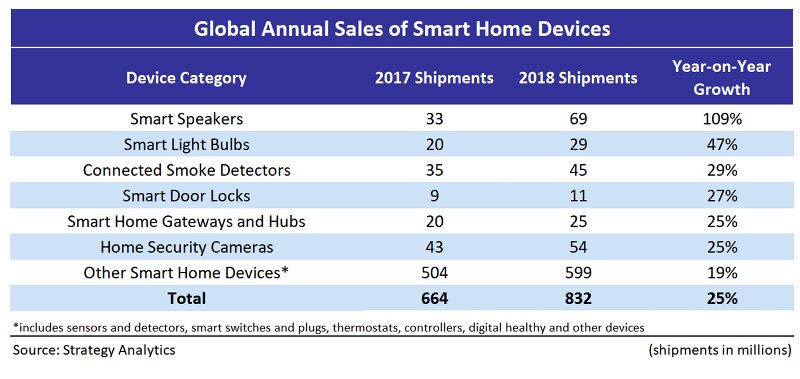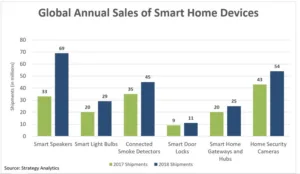Global demand for smart home devices will exceed sales of smartphones by 2023, according to Strategy Analytics. Consumers worldwide bought 664 million smart home devices in 2017 and this will increase to 1.94 billion in 2023, when sales of smartphones will be 1.86 billion.
The research includes various categories of smart home device, including smart speakers, security cameras, smart light bulbs, smart door locks, digital thermostats, gateways and sensor devices. Demand is being driven by lower device prices, compelling user applications and services, improved user experience and rapid technology development.

The fastest growing category in 2018 will be smart speakers, such as Amazon Alexa and Google Home, with a growth rate of 109%. Other fast-growing segments include smart light bulbs (such as the Philips Hue), connected smoke detectors, smart door locks (such as Amazon’s August Smart Lock), gateways and hubs and security cameras (such as Google’s Nest Cam). Strategy Analytics’ Bill Ablondi commented:
“The emergence of the smart home as a popular concept in recent years has led to a wealth of new device opportunities for vendors and technology developers.
The smart home device landscape is still in its formative stage and multiple players are fighting to establish a presence. The scale of future demand suggests that there are huge opportunities for vendors which are able to take the lead in improving how people manage and organise their homes”.
The report concludes that successful smart home device vendors should identify which barriers to adoption they need to address to unlock growth, which bundles of products and services will resonate with consumers and which segments they should focus their resources on.
Analyst Comment
This category is probably the segment with the highest prospective growth. However, although many of these devices might have some type of display, most of them are likely to be very small and of incredibly low value, with interface requirements that need higher resolution, touch etc, being supported by what Matt calls “Bring your own display” – i.e. smartphones, tablets and PCs.

